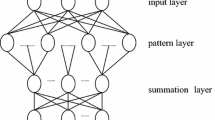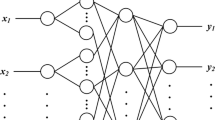Abstract
A western North Pacific tropical cyclone (TC) intensity prediction scheme has been developed based on climatology and persistence (CLIPER) factors as potential predictors and using genetic neural network (GNN) model. TC samples during June–October spanning 2001–2010 are used for model development. The GNN model input is constructed from potential predictors by employing both a stepwise regression method and an Isometric Mapping (Isomap) algorithm. The Isomap algorithm is capable of finding meaningful low-dimensional architectures hidden in their nonlinear high-dimensional data space and separating the underlying factors. In this scheme, the new developed model, which is termed the GNN-Isomap model, is used for monthly TC intensity prediction at 24- and 48-h lead times. Using identical modeling samples and independent samples, predictions of the GNN-Isomap model are compared with the widely used CLIPER method. By adopting different numbers of nearest neighbors, results of sensitivity experiments show that the mean absolute prediction errors of the independent samples using GNN-Isomap model at 24- and 48-h forecasts are smaller than those using CLIPER method. Positive skills are obtained as compared to the CLIPER method with being above 12 % at 24 h and above 14 % at 48 h. Analyses of the new scheme suggest that the useful linear and nonlinear prediction information of the full pool of potential predictors is excavated in terms of the stepwise regression method and the Isomap algorithm. Moreover, the GNN is built by integrating multiple individual neural networks with the same expected output and network architecture is optimized by an evolutionary genetic algorithm, so the generalization capacity of the GNN-Isomap model is significantly enhanced, indicating a potentially better operational weather prediction.

Similar content being viewed by others
References
Aberson SD (1998) Five-day tropical cyclone track forecasts in the North Atlantic Basin. Weather Forecast 13:1005–1015
Bessafi M, Lasserre-Bigorry A, Neumann CJ, Pignolet-Tardan F, Payet D, Lee-Ching-Ken M (2002) Statistical prediction of tropical cyclone motion: an analog—CLIPER approach. Weather Forecast 17:821–831
Cerdeña A, González A, Pérez JC (2007) Remote sensing of water cloud parameters using neural networks. J Atmos Ocean Technol 24:52–63
Chadwick R, Grimes D (2012) An artificial neural network approach to multispectral rainfall estimation over Africa. J. Hydrometeorol 13:913–931
Chand SS, Walsh KJE (2011) Forecasting tropical cyclone formation in the Fiji region: a probit regression approach using bayesian fitting. Weather Forecast 26:150–165
Chen L, Luo H, Duan Y, Yu H (2004) An overview of tropical cyclone and tropical meteorology research progress. Adv Atmos Sci 21(3):505–514
Chen J, Yuan B, Pei B (2008) Face recognition using two dimensional Laplacian eigen map. J Electron 25(5):616–621
Chen P, Yu H, Chan JCL (2011) A western North Pacific tropical cyclone intensity prediction scheme. Acta Meteorologica Sinica 25(5):611–624
Duan Y, Wu R, Yu H, Liang X, Chan JCL (2004) The role of β-effect and a uniform current on tropical cyclone intensity. Adv Atmos Sci 21(1):75–86
Fabio B (2008) A local linear embedding module for evolutionary computation optimization. J Heuristics 14(1):95–116
Gao S, Chiu LS (2012) Development of statistical typhoon intensity prediction: application to satellite-observed surface evaporation and rain rate (STIPER). Weather Forecast 27:240–250
Goldberg DE, Holland JH (1988) Genetic algorithms and machine learning. Mach Learn 3:95–99
Jin L, Yao C, Huang X-Y (2008) A nonlinear artificial intelligence ensemble prediction model for typhoon intensity. Mon Weather Rev 136:4541–4554
Knaff JA, Sampson CR, DeMaria M (2005) An operational statistical typhoon intensity prediction scheme for the western North Pacific. Weather Forecast 20:688–699
Kwong KM, Wong MHY, Liu JNK, Chan PW (2012) An artificial neural network with chaotic oscillator for wind shear alerting. J Atmos Ocean Technol 29:1518–1531
Lu MM, Chu P-S, Lin Y-C (2010) Seasonal prediction of tropical cyclone activity near Taiwan using the bayesian multivariate regression method. Weather Forecast 25:1780–1795
Lund IA (1971) An application of stagewise and stepwise regression procedures to a problem of estimating precipitation in California. J Appl Meteorol 10:892–902
Nabney IT (2002) NETLAB: algorithms for pattern recognition. Advances in pattern recognition. Springer-Verlag, New York
North GR, Bell TL, Cahalan RF, Moeng FJ (1982) Sampling errors in the estimation of empirical orthogonal functions. Mon Weather Rev 110:699–706
Piñeros MF, Ritchie EA, Tyo JS (2011) Estimating tropical cyclone intensity from infrared image data. Weather Forecast 26:690–698
Ritchie EA, Genevieve VK, Piñeros MF, Tyo JS (2012) Tropical cyclone intensity estimation in the North Atlantic Basin using an improved deviation angle variance technique. Weather Forecast 27:1264–1277
Root B, Yu T-Y, Yeary M, Richman MB (2010) The added value of surface data to radar-derived rainfall-rate estimation using an artificial neural network. J Atmos Ocean Technol 27:1547–1554
Rumelhart DE, Hinton GE, Williams RJ (1986) Learning representations by back-propagating errors. Nature 323:533–536
Shao C, Huang H (2005) Improvement of data visualization based on ISOMAP. MICAI 2005. Adv Artif Intell 3789:534–543
Tenenbaum JB, Silva VD, Langford JC (2000) A global geometric framework for nonlinear dimensionality reduction. Science 290(5500):2319–2323
Torgerson WS (1952) Multidimensional scaling: I theory and method. Psychometrika 17:401–419
Weng S, Zhang C, Lin Z, Zhang X (2005) Mining the structural knowledge of high-dimensional medical data using Isomap. Med Biol Eng Comput 43(3):410–412
Xiang J, Weng J, Zhuang Y, Fei W (2006) Ensemble learning HMM for motion recognition and retrieval by Isomap dimension reduction. J Zhejiang Univ Sci A 7(12):2063–2072
Xu A, Guo P (2006) Isomap and neural networks based image registration scheme. Adv Neural Netw (ISNN 2006) 3972:486–491
Yip ZK, Yau MK (2012) Application of artificial neural networks on North Atlantic tropical cyclogenesis potential index in climate change. J Atmos Ocean Technol 29:1202–1220
Yu H, Chen P, Li Q, Tang B (2013) Current capability of operational numerical models in predicting tropical cyclone intensity in the western North Pacific. Weather Forecast 28:353–367
Zhang S, Li T, Ge X, Peng M, Pan N (2012) A 3DVAR-based dynamical initialization scheme for tropical cyclone predictions. Weather Forecast 27:473–483
Acknowledgments
This work was supported by the National Natural Science Foundation of China (Grant 41065002 and Grant 61203301) and the Natural Science Foundation of Guangxi (Grant 2011GXNSFE018006).
Author information
Authors and Affiliations
Corresponding author
Additional information
Responsible editor: B. Ahrens.
Appendix
Appendix
1.1 Key acronyms and abbreviations
- ANN:
-
Artificial neural network
- ANNs:
-
Artificial neural networks
- BPNN:
-
Back-propagation neural network
- BPNNs:
-
Back-propagation neural networks
- CLIPER:
-
Climatology and persistence
- GA:
-
Genetic algorithm
- GNN:
-
Genetic neural network
- GNN-Isomap:
-
GNN with employing both stepwise regression method and Isomap algorithm for constructing model input
- Isomap:
-
Isometric mapping
- MDS:
-
Multidimensional scaling
- TC:
-
Tropical cyclone
- TCs:
-
Tropical cyclones
Rights and permissions
About this article
Cite this article
Huang, Y., Jin, L. A prediction scheme with genetic neural network and Isomap algorithm for tropical cyclone intensity change over western North Pacific. Meteorol Atmos Phys 121, 143–152 (2013). https://doi.org/10.1007/s00703-013-0263-7
Received:
Accepted:
Published:
Issue Date:
DOI: https://doi.org/10.1007/s00703-013-0263-7




